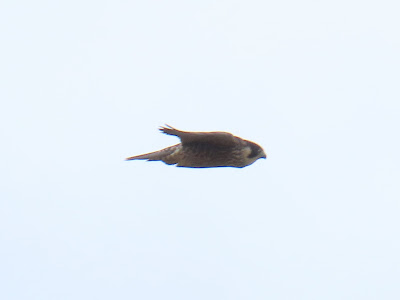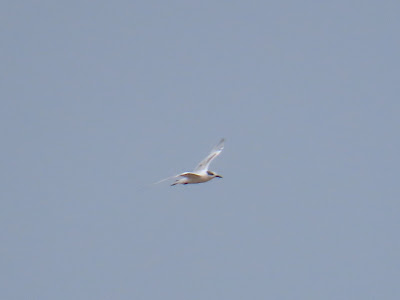Saying train and bus trip would have made for a very long title, but I caught the train to Bridlington and then walked to the bus station to catch East Yorkshire bus 14 to North Landing. In today's walk I followed the coastal path from North Landing, around the tip of Flamborough Headland and then returns via South Landing to catch the bus back at Church Street, Flamborough. The walk is about 11 km.
I start by descending the ramp to South Landing to check the House Martin colony on the cliffs. The beach is busy with people. A coble is about to leave for a boat trip, passengers on board. I walk to the west end of the beach. There are several active House Martin nests and in one of them the chicks were visible.
One of my aims for the day was to see the seals at the little beach at the headland by High Stacks. I hadn't tought about the tide though. It had been high tide an hour earlier, and there was a fair amount of beach exposed. There were many seals just off the beach, watching. There was a thick band of seaweed between the seals and the beach. A couple managed to go past the weed and onto the beach, but there was a fair amount of growling.
The beach was busy with waders, all in small numbers: Turnstones, a Ruff, a Sanderling, a Ringed Plover. Herring Gulls and Great Black-backed gulls completed the cast. I have my packed lunch on the grass over High Stacks, by a lovely clump of Harebells, hoping for the tide to ebb a bit, and afterwards I watch the seals some more before carrying on with my walk.
Kestrels hover over the cliff top at regular intervals, the cries from Oystercatchers coming from the hidden beach below. South Landing comes into view, I glimpse an arrow of dark wings disappearing behind the cliff: a Peregrine! I wait and it reappears, chasing a flock of small waders, they fly close to the water and the Peregrine leaves them, only to cause mayhem amongs gulls, some hurriedly diving to escape. It chases a Black-headed Gull and misses, and then it disappears again behind the cliffs after a couple of passes overhead. Wow! One of those amazing wildlife moments! Only then I see a male Kestrel, hunkering on the cliff edge near me. I guess he's seen all the action too! What a way to finish the walk. I take a short detour around the woods before heading to Church street to catch the bus back to Bridlington.
























































